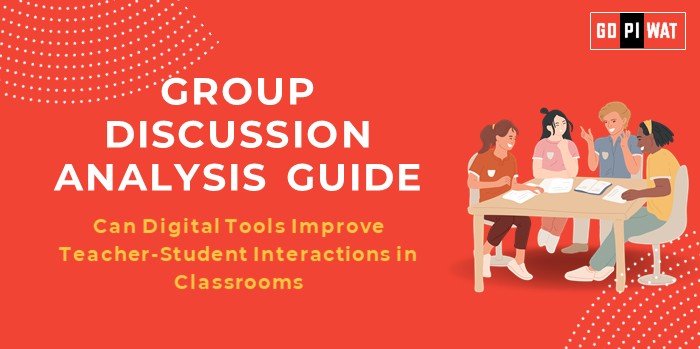📋 Can Digital Tools Improve Teacher-Student Interactions in Classrooms?
🌐 Group Discussion Analysis Guide
💡 Introduction to the Topic
Opening Context: Digital tools have revolutionized global education by enhancing access, engagement, and interactivity in classrooms. Their importance is underscored in shaping the future workforce for a digital-first world.
Topic Background: The integration of technology in education gained momentum with advancements like smartboards, digital content platforms, and AI-driven personalized learning. This trend accelerated during the COVID-19 pandemic, which forced schools worldwide to adopt digital classrooms.
📊 Quick Facts and Key Statistics
- 🌍 Digital Penetration in Education: Over 65% of teachers worldwide now use digital tools in classrooms (UNESCO, 2023).
- 💻 Online Platforms: Platforms like Google Classroom reached over 150 million users globally during the pandemic.
- 📈 Engagement Boost: Classrooms using interactive tools report 20% higher student engagement (EdTech Magazine, 2024).
- 🇮🇳 India’s Investment: ₹1,500 crore allocated for digital infrastructure in schools in FY 2023-24 (MHRD).
🤝 Stakeholders and Their Roles
- 👩🏫 Teachers: Adopting digital tools to enhance teaching methodologies and improve student engagement.
- 👨🎓 Students: Benefiting from personalized, interactive learning experiences that cater to diverse learning needs.
- 🏫 Educational Institutions: Investing in digital infrastructure and providing teacher training programs.
- 💡 EdTech Companies: Developing innovative and user-friendly tools such as interactive platforms and AI-driven apps.
- 🏛️ Government and NGOs: Supporting policy frameworks, providing funding, and addressing digital inequities.
🏆 Achievements and ⚠️ Challenges
✨ Achievements:
- 🚀 Enhanced Engagement: Interactive tools like Kahoot and Flipgrid make learning fun and participatory.
- 🤖 Personalized Learning: AI-driven apps such as Duolingo tailor content to individual learning paces and preferences.
- 🌍 Accessibility: Remote education initiatives reached over 40 million rural Indian students (MHRD, 2023).
⚠️ Challenges:
- 📉 Digital Divide: 55% of rural students in India lack access to digital tools and reliable infrastructure (UNICEF).
- 👩🏫 Training Gaps: Teachers often struggle to adopt and effectively use advanced technologies in classrooms.
- 🔍 Screen Dependency: Excessive reliance on screens may lead to reduced attention spans and other health concerns.
🌍 Global Comparisons:
- 🇫🇮 Success in Finland: High digital literacy among teachers and students ensures seamless technology integration in classrooms.
- 🌍 Challenges in Africa: Limited infrastructure and financial constraints hinder digital adoption in classrooms.
🗣️ Structured Arguments for Discussion
- Supporting Stance: “Digital tools enhance interactivity, boost learning outcomes, and foster higher engagement levels in classrooms.”
- Opposing Stance: “Over-reliance on digital tools risks diminishing critical thinking, interpersonal skills, and in-person engagement.”
- Balanced Perspective: “While transformative, digital tools need careful implementation to avoid exacerbating inequalities and creating over-dependence on technology.”
💬 Effective Discussion Approaches
🔹 Opening Approaches:
- 📊 Statistical Highlight: “Over 65% of teachers globally use digital tools, reporting a 20% boost in student engagement.”
- 🌟 Case Study: “Khan Academy’s widespread success has demonstrated the potential of digital tools to transform global education.”
🔄 Counter-Argument Handling:
- 💡 Address screen dependency concerns by emphasizing the importance of a balanced use of digital and traditional methods.
- 🏫 Highlight hybrid models and policy reforms as solutions for inclusivity and effective technology implementation.
📊 Strategic Analysis of Strengths and Weaknesses
- 💪 Strengths: Engages students with diverse learning styles, enhances global resource access, and improves classroom interactivity.
- 🔻 Weaknesses: Heavy reliance on infrastructure, significant teacher training gaps, and growing privacy concerns with EdTech tools.
- 🚀 Opportunities: Expansion of 5G for rural connectivity and adoption of AI-driven adaptive learning.
- ⚠️ Threats: Cybersecurity risks, inequities in digital access, and pandemic-induced disruptions.
📚 Connecting with B-School Applications
Real-World Applications:
- 💼 EdTech Startups: Business models focusing on operations, scalability, and market outreach.
- 🌍 Diverse Business Strategies: Leveraging digital tools for workforce training and management education.
🔍 Sample Interview Questions:
- 💬 “How can digital tools bridge educational gaps and foster better teacher-student interactions?”
- 📊 “Evaluate the effectiveness of AI and virtual classrooms in improving learning outcomes.”
💡 Insights for B-School Students:
- 📊 Explore EdTech market dynamics and the role of technology in driving educational innovation.
- 🚀 Analyze technology’s role in solving inequities and delivering scalable educational solutions.


